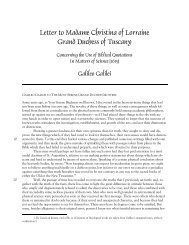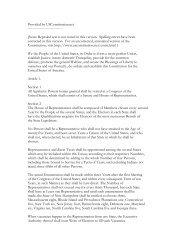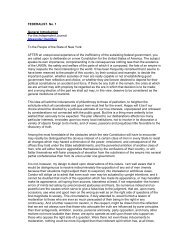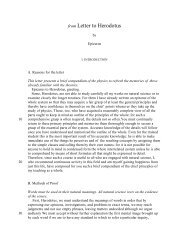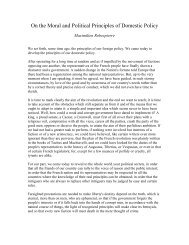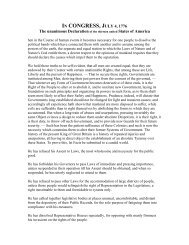Download this issue as a PDF - Columbia College - Columbia ...
Download this issue as a PDF - Columbia College - Columbia ...
Download this issue as a PDF - Columbia College - Columbia ...
Create successful ePaper yourself
Turn your PDF publications into a flip-book with our unique Google optimized e-Paper software.
KENNETH T. JACKSON<br />
COLUMBIA COLLEGE TODAY<br />
COLUMBIA COLLEGE TODAY<br />
KENNETH T. JACKSON<br />
known. They had read in newspapers and listened on radios<br />
about the Luftwaffe blitz on London in the fall of 1940. Would<br />
American co<strong>as</strong>tal cities — New York chief among them — become<br />
targets for bombing What about submarine attacks After<br />
all, German U-Boats — Hitler’s fleet of attack submarines — had<br />
already been waging a relentless under sea war against Atlantic<br />
shipping, and they would presumably redeploy to American<br />
waters to attack defenseless oil tankers and cargo ships along the<br />
E<strong>as</strong>t Co<strong>as</strong>t, crippling American supply lines.<br />
Initially, the Empire City did seem vulnerable. Although German<br />
bombers never had the range to reach the United States,<br />
U-boats could reach New York, and during the first four months<br />
of 1942, enemy undersea vessels sank eighty-seven ships in the<br />
Atlantic. One of the first victims w<strong>as</strong> the Coimbra, a British tanker<br />
transporting American oil to Britain. On January 5, 1942, thirty<br />
miles off Long Island, she w<strong>as</strong> sunk by a single torpedo from a<br />
U-boat, and the captain and thirty-five crewmen perished; only<br />
six injured survivors were rescued from the freezing waters of<br />
the Atlantic.<br />
New Yorkers quickly adapted to the mobilization that war<br />
demanded. Thousands of volunteer aircraft spotters and air raid<br />
wardens turned out for duty twenty-four hours a day. On June<br />
13, 1942, a giant “New York at War” parade saw five hundred<br />
thousand participants march up Fifth Avenue from W<strong>as</strong>hington<br />
Square to 79th Street. It took eleven hours for all the civilians and<br />
members of every service to p<strong>as</strong>s in front of more than two million<br />
cheering onlookers. Two days later, Mayor La Guardia told<br />
radio listeners in his weekly program that he would go to W<strong>as</strong>hington<br />
to demand more war contracts; the city, he said, had v<strong>as</strong>t<br />
resources to support the war, including millions of square feet of<br />
empty factory space, tens of thousands of vacant apartments, and<br />
three hundred thousand unemployed workers.<br />
With the entrance of the United States into the war, the military<br />
presence in and around the city grew dramatically. B<strong>as</strong>es<br />
like Floyd Bennett Field and Fort Hamilton in Brooklyn, Fort<br />
Dix in New Jersey, Fort Wadsworth on Staten Island, Fort Tilden<br />
in Rockaway Beach, Fort Hancock on Sandy Hook, and Camp<br />
Smith to the north all expanded swiftly. The Navy established<br />
the E<strong>as</strong>tern Sea Frontier, under the command of Vice Admiral<br />
Adolphus Andrews from his headquarters at 90 Church Street<br />
in Manhattan, to monitor ship movements along the co<strong>as</strong>t. It also<br />
installed a submarine net between Staten Island and Brooklyn to<br />
prevent incursions by U-boats into the harbor. Co<strong>as</strong>tal artillery<br />
batteries went up along the south shore of Brooklyn, the e<strong>as</strong>t side<br />
of Staten Island, and on the edges of Long Island Sound. Fortunately,<br />
they never were forced into action.<br />
The only real Axis test came in the early morning hours of<br />
June 13, 1942, when a U-boat took advantage of fog and landed<br />
four German saboteurs on the beach at Amagansett, Long Island.<br />
Carrying four crates of explosives and $84,000 in c<strong>as</strong>h, they were<br />
instructed to wait six weeks and then begin to destroy American<br />
war-making facilities. Unfortunately for the saboteurs, a Co<strong>as</strong>t<br />
Guardsman patrolling the beach spotted them soon after they<br />
had buried their uniforms and detonators. In desperation, they<br />
paid the beach patrolman $260 to buy his silence. They took an<br />
Would American co<strong>as</strong>tal cities — New York chief among them —<br />
become targets for bombing What about submarine attacks<br />
The Army’s recruiting office at 39 Whitehall Street in<br />
lower Manhattan became one of the busiest such facilities<br />
in the United States <strong>as</strong> New Yorkers, like their<br />
countrymen across the land, joined the service to<br />
defend their country. Between 1942 and 1945, more<br />
than a million persons in the metropolitan region served in the<br />
armed forces, and military uniforms became ubiquitous on the<br />
city streets. The New York area became a major center for training<br />
<strong>as</strong> well. Roughly twenty-four thousand men were graduated<br />
from the U.S. Naval Reserve Midshipmen’s School at <strong>Columbia</strong><br />
University, meaning that more officers were trained in New York<br />
during World War II than at the Naval Academy in Annapolis.<br />
The Navy’s Women Accepted for Volunteer Emergency Service<br />
(WAVES) had its most important national training site at Hunter<br />
<strong>College</strong> (now Herbert H. Lehman <strong>College</strong>) in the Bronx, the<br />
United States Co<strong>as</strong>t Guard maintained its largest training station<br />
at Manhattan Beach in Brooklyn, and two-thirds of all merchant<br />
seamen who sailed the Liberty and Victory ships carrying supplies<br />
to the front were trained in the city.<br />
The industrial achievement of the United States in World War II<br />
w<strong>as</strong> phenomenal by any me<strong>as</strong>ure. In 1940, when President Roosevelt<br />
<strong>issue</strong>d a call for the production of fifty thousand airplanes per<br />
year, it w<strong>as</strong> widely felt to be a pipe dream. Yet by 1944, American<br />
factories were producing almost one-hundred thousand airplanes<br />
per year — about twice <strong>as</strong> many <strong>as</strong> both Germany and Japan together<br />
and almost <strong>as</strong> many <strong>as</strong> the rest of the world combined. Statistics<br />
for jeeps, artillery pieces, self-propelled guns, oil, aluminum,<br />
and bombs were equally dramatic. The nation produced so many<br />
trucks and shoes that it shared its resources with the British Army<br />
and the Red Army, both of which desperately needed them. Meanwhile,<br />
America’s shipyards produced so many vessels that by the<br />
end of the conflict, the United States Navy w<strong>as</strong> not only larger than<br />
that of any other nation, but it w<strong>as</strong> larger and more powerful than<br />
all other navies in the world combined.<br />
While World War II helped end the Great Depression of the<br />
1930s by providing jobs for the unemployed, New York w<strong>as</strong><br />
slower to come out of the crisis than other industrial cities, and<br />
it received smaller war contracts than other places. In part, <strong>this</strong><br />
reflected the federal policy of favoring big companies because<br />
they could ramp of war production f<strong>as</strong>ter than smaller companies<br />
could. The degree of concentration w<strong>as</strong> startling. Through<br />
the summer of 1942, the largest one hundred firms in America<br />
had received seventy-three percent of the war contracts by dollar<br />
value. But Gotham’s twenty-seven thousand factories, ever<br />
small, averaged only fifteen employees each, nothing like General<br />
Motors, Ford, and the Chrysler Corporation. And New York<br />
companies typically were not oriented to the production of tanks,<br />
rifles, boots, artillery, airplanes, jeeps, trucks, armored personnel<br />
carriers, and other major instruments of war. Not surprisingly,<br />
Detroit received approximately six times the per capita volume<br />
of contracts <strong>as</strong> New York did, and Newark, San Francisco, Cleveland,<br />
and Los Angeles garnered four times <strong>as</strong> much <strong>as</strong> Gotham.<br />
As a result, New York still had an unemployment crisis <strong>as</strong> late <strong>as</strong><br />
1942, when a special delegation went to W<strong>as</strong>hington to convince<br />
federal officials to spend more money in the nation’s largest city.<br />
With the delegation’s success in W<strong>as</strong>hington, New York’s industry<br />
grew rapidly. By 1944, there were a record 1.86 million people<br />
in manufacturing jobs in the city, of which seven-hundred thou-<br />
On December 7, 1941, Japanese airplanes<br />
launched a surprise Sunday morning<br />
attack on the United States Pacific Fleet<br />
at its anchorage at Pearl Harbor in the<br />
Hawaiian Islands. The skilled pilots of<br />
the Rising Sun disabled or sank all eight<br />
American battleships in port and killed<br />
more than 2,400 sailors, soldiers, and<br />
civilians. The next day, a resolute FDR<br />
spoke of the attack <strong>as</strong> “a day which will live in infamy” and <strong>as</strong>ked<br />
a joint session of Congress for a declaration of war against Japan.<br />
On December 11, Germany declared war on the United States,<br />
even though Hitler’s defensive agreement with Japan did not require<br />
the Third Reich to act unless Japan were the victim, not the<br />
aggressor.<br />
When the United States entered the war, New York w<strong>as</strong> the<br />
largest city in the world, with more than seven million residents<br />
in the five boroughs and another four million in the nearby suburbs.<br />
Even during the Great Depression, New York’s harbor w<strong>as</strong><br />
the busiest, its skyscrapers the tallest, its land values the highest,<br />
and its industrial output the greatest of any city in the world.<br />
Fifth Avenue already w<strong>as</strong> synonymous with shopping, Broadway<br />
with theater, Madison Avenue with advertising, and Wall<br />
Street with finance. The great radio networks and publishing<br />
empires were all headquartered in Manhattan, and the New York<br />
Stock Exchange w<strong>as</strong> the financial world’s dominant trading floor.<br />
Once war w<strong>as</strong> declared, residents of the city faced the un-<br />
early morning commuter train to Manhattan, while the Co<strong>as</strong>t<br />
Guardsman immediately reported the incident to his superiors.<br />
The hunt w<strong>as</strong> soon under way.<br />
Trying to blend in with the millions of other people in the great<br />
city, the four conspirators took a room on the Upper West Side,<br />
mingled with other sightseers at Grant’s Tomb, walked around<br />
<strong>Columbia</strong> University, shopped at the Rogers Peet men’s store on<br />
Fifth Avenue, listened to jazz, and visited a brothel. Despite their<br />
infiltration, the saboteurs never blew up anything. They were<br />
caught (along with four accomplices who had come <strong>as</strong>hore in<br />
Florida) after two of them traveled to W<strong>as</strong>hington and confessed<br />
to the FBI. President Roosevelt ordered a closed military trial for<br />
the Germans. All were sentenced to death; FDR commuted the<br />
sentences of the two who had confessed; the remaining six were<br />
executed on August 8, 1942.<br />
Although sabotage remained a real threat, not all losses came<br />
at the hands of the Axis. On February 9, 1942, the S.S. Normandie,<br />
the most luxurious ocean liner in the world, w<strong>as</strong> moored at Pier<br />
88 on the West Side. Once the property of France, which w<strong>as</strong> at<br />
<strong>this</strong> point occupied by Germany, the ship had been confiscated<br />
by the United States after war began and rechristened the U.S.S.<br />
Lafayette for the purpose of taking American troops to Europe.<br />
The ship caught fire during its conversion when sparks from a<br />
welder’s torch allegedly ignited a pile of life vests. Several fireboats<br />
and dozens of fire companies were on the scene within<br />
minutes. But the flames were not e<strong>as</strong>ily extinguished, and the<br />
firefighters poured so much water into the vessel that, in the early<br />
hours of February 10, 1942, it capsized at its berth.<br />
Navy midshipmen stand at attention with their respective units during a drill on South Field in 1942.<br />
PHOTO: PACH BROS., N.Y.; GIFT OF CHARLES A. RIDDLE III, COURTESY COLUMBIA UNIVERSITY ARCHIVES<br />
SUMMER 2013<br />
38<br />
SUMMER 2013<br />
39




